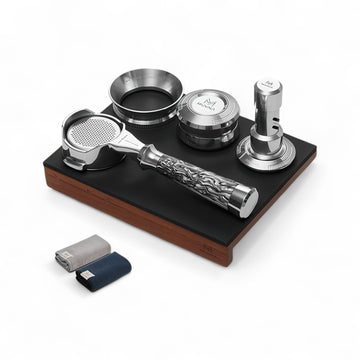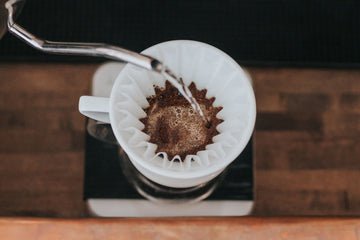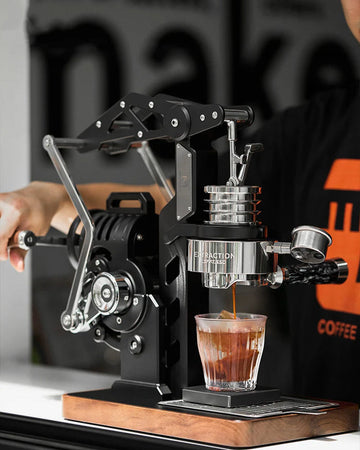Making a nice cup of coffee at home is a piece of cake. However, there are a few basic rules to find the golden ratio. One of them is how much filter coffee to use in a cup and the coffee-to-water ratio. Once you have the principles, you will want to make the best cup of coffee every time. Now, we will have to dig deeper into the article.
Understanding coffee measurements
Most coffee lovers can make their coffee cups without much hassle. They know the true amount of coffee and water to use. However, what happens when they need to make a pot of coffee when they are used to getting single cups? How much filter coffee do you use when you have to make coffee for your friends or families? This is the time you should understand coffee measurements.
Tablespoon and weights
When brewing your coffee with a filter machine, it is necessary to notice the measurements. Coffee measurements could be shown either in tablespoons or weights (grams).
A standard tablespoon of coffee keeps about 5 grams, while a cup of coffee brewing expresses to 6 fluid ounces (approximately 170 grams). Please keep in mind that a cup of 8 ounces is used for other purposes, not coffee brewing.
To get the right ratio between coffee and water, the Specialty Coffee Association of Europe (SCAE) suggests that we need to use 60 grams of coffee per 1 liter of water. For 200 milliliters of a cup, you can understand that you use 12 grams of coffee powder. However, you can possibly adjust the ratio based on your taste.
With a scale
A scale is the greatest gadget to determine the amount of water and coffee for brewing. You might use it to decide the precise water and consistent coffee that you will want to add in the brewing process.
Determine how much filter coffee you would like to brew. You want to make 6 cups of coffee, for instance. Most coffee maker manufacturers often use a cup of 6 ounces of liquid coffee. It means that brewing a 6-cup pot of coffee is equal to 36 ounces of liquid coffee.
Most coffee lovers and gurus utilize a metric system when measuring coffee and water. This is because the math is simpler than translating to grams and milliliters. Moreover, people living in most countries use these units of measure in their lives.
You could convert 36 ounces to milliliters, for example. 36 liquid ounces is equal to about 1,020 milliliters of coffee or over 1 liter. 1 ounce is equivalent to about 28.35 milliliters. When having the total amount of water, you probably decide the amount of coffee grounds to use in your brewing.
This is where your great water-to-coffee ratio of 16:1 appears. You get the total weight of the water (in milliliters) and divide by 16. For instance, if you divide 1020 milliliters of water by 16, it comes to 64 grams. 1 milliliter is equal to 1 gram. This is the amount of filter coffee you could use in brewing a pot of coffee for 6 cups.
With a scoop
A scoop of coffee is around 10 grams of filter coffee. Although it is not a basic unit of measure, some grind sizes have scoops. The real weight could vary for different reasons. Coffee that is more softly filtered will weigh more in the similar scoop than coffee that is ground more roughly. This is because the finer ground may fit into the scoop and many small particles can pack into it. Different weights and shapes are other reasons that all scoops are disparate.
For instance, each scoop of filter coffee is equal to 10 grams. For each cup of your coffee that you want to brew, you need to use an appropriate scoop. If you would like to brew a pot with 6 cups, add 6 scoops of filter coffee.
What is the coffee brew ratio?
Although ratios are…subjective, most coffee cups are brewed around a certain ratio. The amount of coffee and used water in a brew (1: 18 – 1 part of the coffee and 18 parts of water). In case you want to enjoy a strong cup of coffee, you can adjust the ratio to 1:15. If you need to take a light cup, 1:18 will be better.
Espresso, on the flip side, has a different ratio. 1:2 is a good ratio for your
Espresso cup (1 gram of coffee to 2 grams of water). This is because the coffee is a concentrate and it is diluted in milk or water.
Why should we use a brew ratio?
We often talk about recipes in cooking or baking. However, we do not mention it in coffee brewing. Why should we use the ratio instead? This is because you can scale up and down the water and beans easily. At the same time, you could use 2 different weight measurements (grams or ounce) whether you live in the East or West regions. People do not use recipes.
Simply use a precise digital scale and follow the appropriate ratio. Coffee beans vary in densities because of growing conditions and roast style. Thus, it is vital to use a digital scale when weighing out the coffee and when brewing.
Should I use scoops? Well, scoops will not be accurate in the long term. The coffee beans are different and the brewing methods are not the same. Eyeballing the amount of water and coffee will always be incorrect. Just use scoops to make milk powder with the amount of water.
The golden ratio in brewing coffee
It depends on the habits. You can try 4 ratios:
- 1:15 (regular coffee): if you brew regular coffee for someone without specific request, then you can select a 1:15 ratio. This ratio might balance milk, water, and coffee. It also does not require black or white coffee.
- 1:14 (French Press): Do you want to enjoy a cup of French Press, Aeropress or cowboy coffee? Then, you should use a 1:14 ratio. It makes your coffee stronger.
- 1:15 (drip coffee): if you are going to pour over your coffee at home and you are a novice, then you should try a medium grind setting with 1:15 ratio.
- 1:16.6 (advanced home-baristas): if you feel bored in a 1:15 ratio, then you would try a high-end grinder with coffee beans and a new roast style. Do not forget to adjust the brewing ratio to 1:16 or 1:17.
Conversions
- 1 tablespoon. = ⅓ tablespoon
- 3 tablespoons = 1 tablespoon
- 2 tablespoons = 1 scoop
Volume equivalents
- 1 Oz = ⅛ cup = Espresso shot
- ¼ cup = 2 Oz. = Double shot Espresso
- ½ cup = 4 Oz.
- 1 US cup = 8 Oz.
- Carafe: 5 Oz. = 1 cup
Apart from your ratio, grind size and brew time have the most tremendous impact in your cup of coffee. Ratio decides how much your coffee is being brewed. Grind size, on the other hand, influences how much soluble quality is dissolving during the brew time. The key here is making a well-balanced and amazing cup of coffee.
How to brew your cups of coffee
This part is a bonus but it will become a necessary one for those who would like to try different coffee styles.
French Press
Measurements: 2 tablespoons for every cup of water
Instructions below
- Step 1: boil the cold and clean water. Then, you grind coffee beans and add them to the French Press (please bear in mind that you have to own a French Press machine)
- Step 2: wait for 30 seconds (at least) to let the water sit in a pot
- Step 3: fill the desired amount of water in the French Press
- Step 4: follow the coffee blooms
- Step 5: stir the grounds
- Step 6: wait for 5 minutes because the coffee is brewing
- Step 7: turn off the machine, pour the coffee to your cups, and enjoy
Pour Over
Instructions below
- Step 1: boil an amount of water in a pot
- Step 2: after boiling water, you need to wait for 30 seconds
- Step 3: place the filter in the right brewer
- Step 4: dampen the filter with hot water in order to wipe filter and preheat the brewer at the same time
- Step 5: pour the water out while holding the filter stayed in place because the coffee does not spill out to the wall
- Step 6: grind the coffee or use the ground coffee. Then, you add the coffee to the filter. Spread the coffee out and make a small surface in the middle
- Step 7: slightly pour a pinch of water (about 100ml) on the grinds so saturate water and wait for 30 seconds to see the grinds bloom.
- Step 8: pour the remaining water over the grounds with 100ml of increments. Use a circular or move back and forth to make sure that the grinds are totally covered. It will help the extraction have a steady motion. Pay close attention to the water to ensure that it does not pour out the outside of the filter. Continue the way till you have used up the water
- Step 9: wait for the drip cycle finish and remove the filter
Espresso
Instructions below
- Step 1: warm your Espresso machine up for a minimum of 20 minutes. Remember to attach porta filter to group ahead
- Step 2: rinse the group head and portafilter and purge the machine at once
- Step 3: use a dry cloth to wipe portafilter
- Step 4: add your favorite coffee beans to the grinder hopper
- Step 5: grind your coffee (about 20 grams) straightly to the portafilter (or the fine grind)
- Step 6: adjust the coffee grinds in the portafilter
- Step 7: tamp the grinds in the tamper. Pressure 30 pounds of coffee in the coffee bed to make sure that the extraction will be even in the upcoming time
- Step 8: slightly turn the grinds in a small circle
- Step 9: lock the portafilter into the group head
- Step 10: put an Espresso cup under the portafilter
- Step 11: kick off the extraction. Make sure each shot has a slow drip and turn into a smooth stream
- Step 12: see the final result
AeroPress
Instructions below
- Step 1: boil fresh and clean water while preparing your AeroPress machine
- Step 2: set the grinder in order to grind the coffee bean
- Step 3: add coffee beans to the hand grinder hopper
- Step 4: grind coffee beans in the hopper. You can use your hands to make the beans finer
- Step 5: push the plunger out of the AeroPress chamber
- Step 6: put a filter in the cap and twist the cap to the chamber
- Step 7: adjust the chamber in order to remain it in a solid mug
- Step 8: pour an amount of water through the chamber to clean the filter and preheat the mug at the same time
- Step 9: diminish the water
- Step 10: put a heaping scoop of ground coffee to the chamber
- Step 11: shake the chamber to make the coffee more even
- Step 12: add hot water to the number 2 (on the chamber)
- Step 13: stir it about 10 minutes
- Step 14: stick plunger to the chamber and press down for one minute
- Step 15: receive your coffee cup
- Step 16: remove the cap and push plunger via chamber to remove used coffee grinds
Key takeaways
Many of us are usually distressed for the first cup of coffee to start the day going. You even do not want to play with coffee scales and the water. You should not figure out the amount of coffee you need to use for a perfect cup when you have to make breakfasts or wake your kids up.
However, it is necessary to discover how much filter coffee to add to a cup. This is because it will determine your flavor and strength after that. Whether it could be tablespoons or a scale, you could take the great coffee cup with the golden ratio every time.













